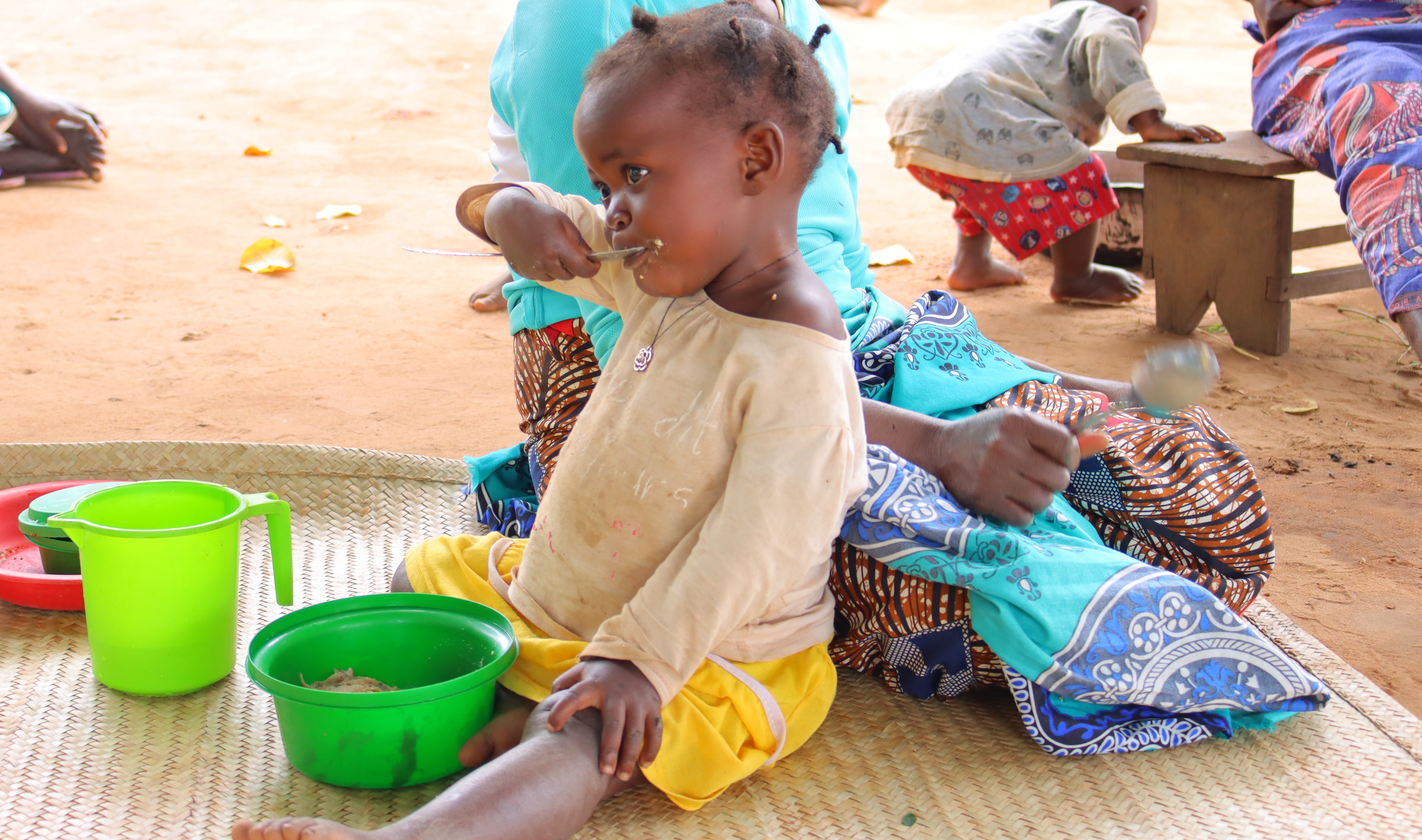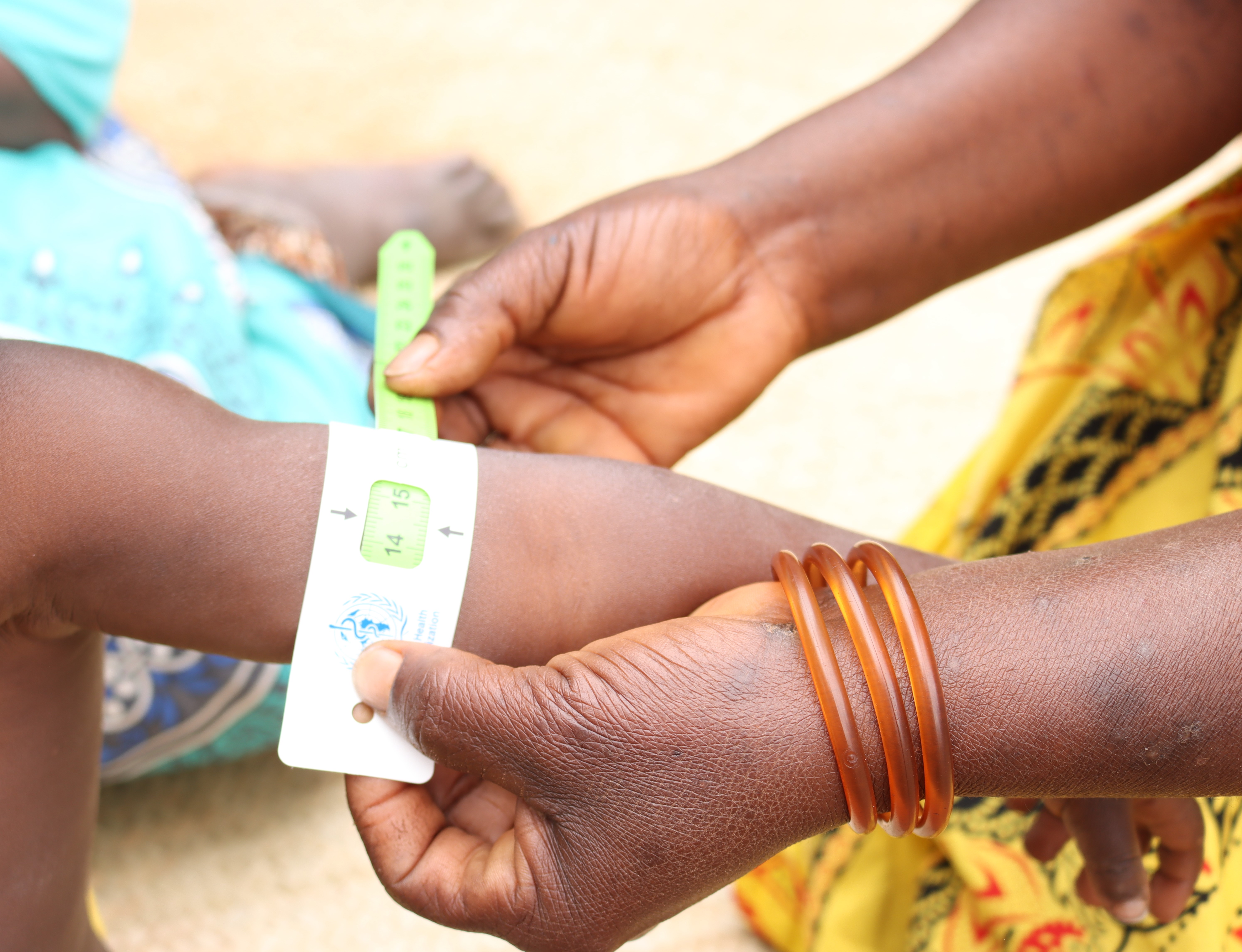Recipes of hope that restore children’s lives
Anatércia, 2 years old, is seated on a straw mat, her small legs wide open and, between them, lays a red plastic plate. With her right hand, she holds a spoon with a tight grip, that slowly dives into a pale brown porridge. As she amounts the necessary quantity of food, her wrist smoothly turns around and rises back to where it came. In a quick move, the porridge disappears into her mouth. For a brief moment, the toddler takes a close look at the back of the spoon. Her eyes, acting as a magnifying glass, are soon to discover small grains of porridge that are swept away with her tongue. Such movement is repeated mechanically until the porridge is finished and the child is satisfied.
Anatércia's mother, Verónica Vitorino, the one who prepared the porridge, is amused by this ordinary scene, and quite often draws a smile seeing her daughter eager to eat. Several months before, Anatércia was a fragile child whose health was diminishing day by day because of malnutrition.
The mother's pregnancy was the prelude to the challenges Anatércia would have to face in her early infancy. Verónica suffered from Hyperemesis Gravidarum, a persistent nausea and vomiting during pregnancy, that can lead to dehydration, weight loss, and electrolyte imbalances. As a result, Anatércia was born prematurely.
The child's condition caught the attention of the Community Health Committee of Chicamalala, during their door-to-door visits, in the rural area of Nacarôa district, Northern Province of Nampula. They helped the mother seek treatment in the local health unit, where Anatércia began treatment with supplementation. Nevertheless, her state still inspired more care.
That is why Anatércia was enrolled in home nutritional rehabilitation sessions where Verónica learned how to prepare fortified foods, like maze porridge, mixed with ingredients such as eggs, moringa leaves, and peanuts. The result was a boost in Anatércia's health.
“The girl was rickety and could not seat straight and struggled to move and crawl. But since I began to feed her with fortified meals she gained weight”, said Verónica, recalling the first signs of malnutrition. As a result of this intervention, the girl’s weight increased from 5,2 kg in March 2021 to 9.3 in March 2022 and now she is out of the danger zone.

Abandoned but not forgotten
Amélia João, 36 years old, lives in Chicamalala and is a mother of seven children abandoned by her husband who fathered the kids. According to her “he went on a journey to the capital city of Nampula to find work”, to improve the family wages, “but he never come back”.
She performs tasks expected of a rural woman with little resources, which means, looking after the household, finding water, and growing crops to feed the children, although agriculture is highly dependent on the climate in this area. Despite these demands, all her attention is now driven to the last of the seven children. One-year-old Ramadan suffers from malnutrition. The baby is so fragile that he cannot seat straight and crawl as a normal baby would. He barely leaves his mother’s lap.
The struggle Amélia endures feeding her newborn child caught the attention of the Community Health Committee of Chicamalala, which convinced her to join the sessions of nutrition rehabilitation, while, at the same time, seeking treatment in the local health facility. These sessions are structured in two parts, where at first, the Community Health Committee assists the child for 12 days uninterruptedly. After this period, the parents, knowing how to prepare fortified meals, can take the lead. For the child’s well-being, Amélia also cooks fortified porridge, with peanuts, moringa leaves, and other supplements available locally. There is a long way to go until the baby is fully recovered, but the solace of the mother and volunteers comes from the fact that Ramadane is full of appetite and eager to eat.
Rehabilitation is a continuous process
Acute malnutrition is a common condition for many early-age children in this region. In face of this situation, Health Committees are working tirelessly to raise awareness among families on ways to improve how food is prepared and fed to toddlers in need of nutritious inputs.
Unfortunately, even after the child no longer is malnourished, long-lasting marks can still be visible. This is the case of Francisco, 8 years old, from Mercurcune village. Yet his stature resembles that of a child who’s five years. He lives with his parents and completed the 12 sessions of nutritional rehabilitation, although still being fed with fortified meals.
“It was in November 2021 that we found the child, during our door-to-door visits, and after measuring his Mid-Upper Arm Circumference (MUAC), which was low, we thought it would be better for him to be taken to the hospital for treatment and start the rehabilitation sessions. We advised the mother to do so and, in Saua-Saua Health Post, he was treated with supplementation”, said Celestino Basílio, who is the president of Mercurcune Health Committee.
The Committee is comprised of 20 members, and 13 of them are female. They make 15 door-to-door visits during a month, monitoring, especially, children in the range of six to 59 months.
Maria Bernardo, 42 years old, is the mother of Francisco plus four children and currently, she is pregnant. She grows cassava, a root vegetable that is the base of the food diet in many districts in Nampula. “Because of the plagues, this year the harvest was not satisfactory”, she explained. However, Maria affirmed that her children don’t go to bed without eating a meal. “I constantly prepare fortified meals to feed my kids, especially Francisco. I don’t go a week without cooking these foods”, assured the mother.
Having fought the battle against malnutrition, the Family of Francisco has the challenge to give proper education to the boy, since has a speech impediment, although he can hear. More concerning, is the fact that he is not enrolled in school. “Once we decide to enroll Francisco in a school but on his first day he had trouble adapting to the new environment. The other thing is that the school is far away from home and there is no one who can travel with him daily”, explained Francisco’s grandfather.

Behaviour change is the key
Nacarôa district has seen a slight reduction of severe and acute malnutrition cases. For instance, according to the data provided by the District Services of Health, Women, and Social Action (SDSMAS, acronym in Portuguese), in 2021, a total of 238 cases of malnutrition were diagnosed. This year, a number of 194 cases have been diagnosed so far. In Nacarôa district, malnutrition is more prevalent in children between 0 to 24 months
However, health authorities are aware of the need to intensify measures to increase children’s well-being. According to the Responsible for the District Nutrition Program, Francisco Pirai, many parents don’t know how to recognize the general signs of malnutrition, although they can sense that their children are not in good health. Hence, they arrive at the Health Units when the child is in a severe condition. In addition, cultural beliefs tend to perpetuate eating habits that handicap the development of the child.
“In our Makhua society, it is believed that a woman should not eat eggs during pregnancy, or else she will give birth to a child without hair. It is also believed that colostrum milk (the first form of breastmilk) is impure. These taboos are erroneous and our duty is to educate the communities”, said Pirai.
Within this cultural and social landscape, the Educating the Children Together-Phase III (ECT-3), a project implemented by World Vision-Moçambique (WV-Moç), understands that behaviour change is crucial so that households can adopt good practices of nutrition and health.
ECT-3 is a school feeding project funded by the United States Department of Agriculture (USDA), in the districts of Muecate and Nacarôa. One of the aims of the program is to Improve student, community, and school administration knowledge and practices around nutrition, health, hygiene, food safety and storage.
Under the nutrition approach, the program is currently working with 61 Community Health Committees (CHC) that have been trained to identify and treat any Pregnant, Lactating Women (PLW) including Children Under Five (CU5) that are suffering from acute malnutrition or other health-related issues. These CHCs have also been trained to monitor child growth using MUAC tapes and provide maternal and child health and nutrition messaging at community events, take-home ration distributions, and in schools.
By Benjamim Capito